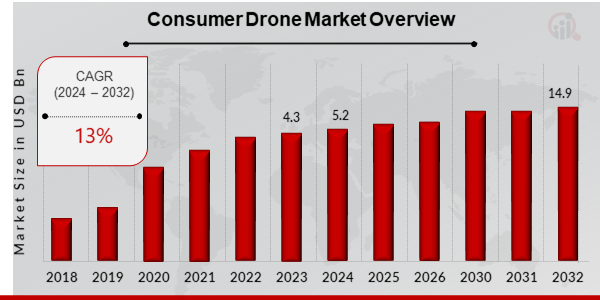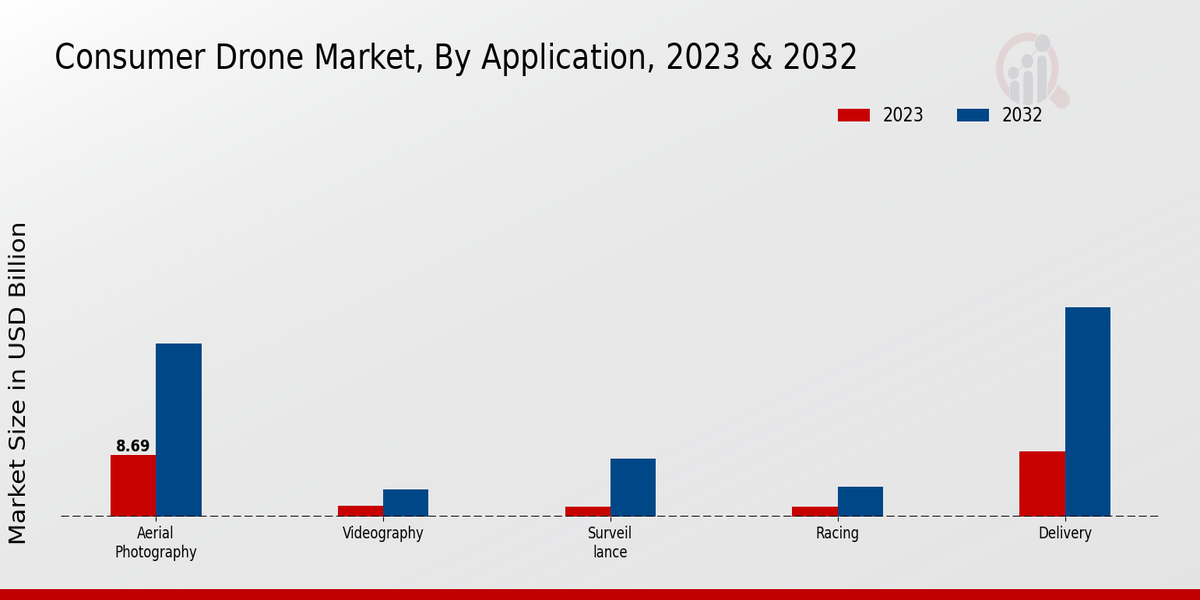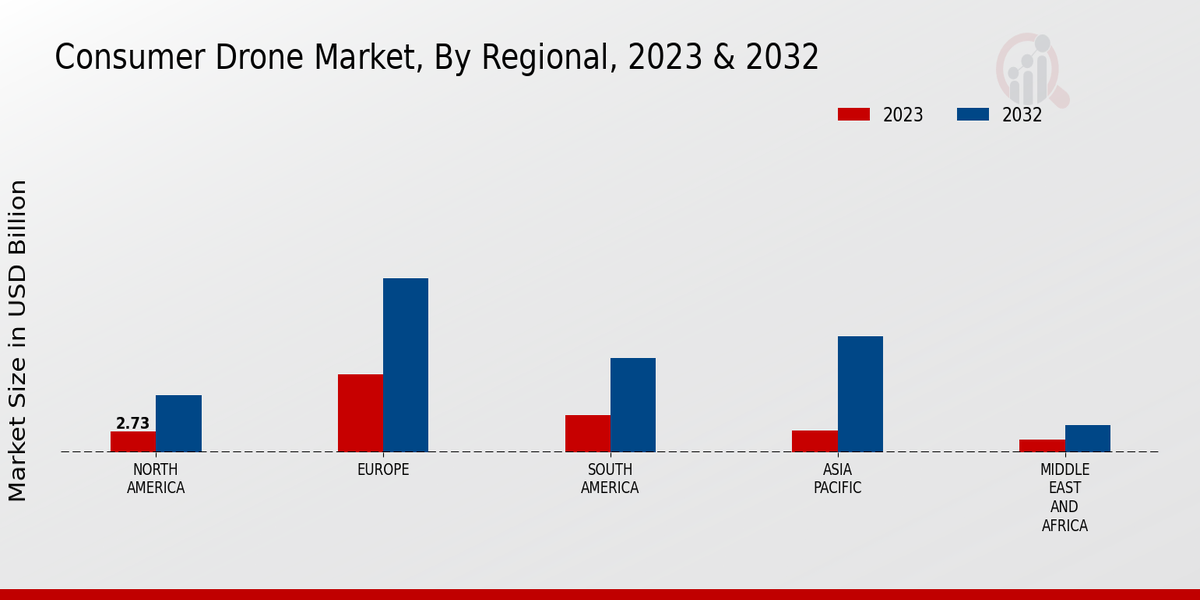Consumer Drone Market Overview
Consumer Drone Market Size was estimated at 4.3 (USD Billion) in 2023. The Consumer Drone Market industry is expected to grow from 5.2 (USD Billion) in 2024 to 14.9 (USD Billion) by 2032. The Consumer Drone Market CAGR (growth rate) is expected to be around 13% during the forecast period (2024 - 2032).
Key Consumer Drone Market Trends Highlighted
Smartphones are the most used device to control consumer drones, as they offer a user-friendly interface and allow for easy access to camera controls and flight settings. In recent years, the use of artificial intelligence (AI) and machine learning (ML) in consumer drones has become increasingly prevalent. AI and ML enable drones to autonomously navigate, avoid obstacles, and track objects, making them more accessible and user-friendly for both recreational and professional users.
The growing popularity of drones in commercial applications presents significant opportunities for market expansion. Drones are increasingly used in industries such as construction, agriculture, and law enforcement, where they offer unique advantages in terms of efficiency, cost-effectiveness, and data collection. Furthermore, the advent of advanced imaging technologies, such as thermal and multispectral imaging, is creating new opportunities for drones in fields such as surveillance, mapping, and inspection.
In recent times, the demand for consumer drones has been influenced by several trends:
Increased Accessibility: The availability of affordable, feature-rich consumer drones has made them more accessible to a wider range of users.
Growing Popularity of Aerial Photography and Videography: The proliferation of social media platforms and the ease of sharing aerial content have fueled the growth of aerial photography and videography.
Advancements in Battery Technology: Improvements in battery technology have extended flight times and increased the versatility of consumer drones.
Emergence of Professional-grade Features: Some consumer drones now offer features that were previously exclusive to professional models, such as high-resolution cameras, advanced stabilization systems, and long-range connectivity.

Source: Primary Research, Secondary Research, MRFR Database and Analyst Review
Consumer Drone Market Drivers
Growing Popularity of Aerial Photography and Videography
The growing popularity of aerial photography and videography is one of the key drivers of the global consumer drone market. Drones allow users to capture stunning aerial footage that was once only possible with expensive equipment and professional photographers. The ease of use and affordability of drones have made them accessible to a wide range of consumers, including hobbyists, photographers, and videographers. The demand for drones is expected to continue to grow as more and more people discover the creative possibilities of aerial photography and videography.The rise of social media has also played a significant role in the growing popularity of drones. Platforms such as Instagram and YouTube have made it easy for people to share their aerial footage with the world. This has created a community of drone enthusiasts who are constantly pushing the boundaries of what is possible with drones. The demand for drones is expected to continue to grow as more and more people discover the creative possibilities of aerial photography and videography.In addition to photography and videography, drones are also being used for a variety of other applications, such as surveillance, mapping, and delivery. The versatility of drones is another key factor that is driving the growth of the market. As drones become more affordable and easier to use, they are expected to become even more popular for a wide range of applications. The Global Consumer Drone Market is expected to grow at a CAGR of 12.2% from 2023 to 2032.
Technological Advancements
The rapid pace of technological advancements is another key driver of the global consumer drone market. Drone manufacturers are constantly developing new and innovative features, such as improved camera quality, longer flight times, and more autonomous flight capabilities. These advancements are making drones more appealing to consumers and are helping to drive the growth of the market. One of the most significant technological advancements in recent years is the development of drones with 4K cameras.4K cameras allow users to capture stunning aerial footage with incredible detail and clarity. This has made drones even more popular for photography and videography. Another key technological advancement is the development of drones with longer flight times. In the past, drones had relatively short flight times, which limited their usefulness for certain applications. However, newer drones are now capable of flying for up to 30 minutes or more on a single charge.This has made drones more practical for a wider range of applications, such as surveillance and mapping. The Global Consumer Drone Market is expected to grow at a CAGR of 12.2% from 2023 to 2032.
Increasing Demand from Emerging Markets
The growing demand from emerging markets is another key driver of the global consumer drone market. In emerging markets, drones are becoming increasingly popular for a variety of applications, such as agriculture, delivery, and infrastructure inspection. In agriculture, drones are being used to monitor crops, spray pesticides, and collect data. Drones can help farmers to improve their yields and reduce their costs. In delivery, drones are being used to deliver goods to remote areas and to provide last-mile delivery services.Drones can help to improve the efficiency and speed of delivery services. In infrastructure inspection, drones are being used to inspect bridges, power lines, and other infrastructure. Drones can help to identify potential problems early on and prevent costly repairs. The Global Consumer Drone Market is expected to grow at a CAGR of 12.2% from 2023 to 2032.
Consumer Drone Market Segment Insights:
Consumer Drone Market Application Insights
The Global Consumer Drone Market segmentation by Application includes Aerial Photography, Videography, Surveillance, Racing, and Delivery. The Aerial Photography segment held the largest market share in 2023, and it is expected to continue its dominance during the forecast period. The growth of this segment can be attributed to the increasing popularity of drones for capturing aerial images and videos. The Videography segment is also expected to witness significant growth in the coming years, owing to the rising demand for drones for filmmaking and video production.The Surveillance segment is expected to grow steadily, driven by the increasing adoption of drones for security and monitoring purposes. The Racing segment is expected to witness moderate growth, as drone racing continues to gain popularity as a competitive sport. The Delivery segment is expected to experience significant growth in the near future, as drones are increasingly being used for last-mile delivery of goods. In 2023, the Global Consumer Drone Market revenue was estimated at 22.12 billion USD. The growth of the market is attributed to the increasing popularity of drones for various applications, such as aerial photography, videography, surveillance, racing, and delivery.The growing adoption of drones by consumers and businesses is also driving the market growth.

Source: Primary Research, Secondary Research, MRFR Database and Analyst Review
Consumer Drone Market Camera Resolution Insights
Camera Resolution is a key segment in the Global Consumer Drone Market, with different resolutions offering varying capabilities and price points. The segment is expected to witness significant growth in the coming years, driven by increasing demand for high-quality aerial photography and videography. 4K resolution is currently the most popular segment, accounting for over 50% of the Global Consumer Drone Market revenue in 2023. It offers a good balance between image quality and affordability, making it a popular choice for both hobbyists and professional photographers and videographers.8K resolution is gaining traction, with increasing demand for higher-quality aerial content. It offers significantly improved image quality over 4K, but at a higher price point. The segment is expected to grow rapidly in the coming years, as the cost of 8K cameras decreases and more consumers adopt higher-resolution displays. 12K, 16K, and 20K resolutions are still relatively niche segments, but they offer the highest image quality available. These resolutions are typically found on high-end professional drones, and are used for specialized applications such as filmmaking and scientific research.As the technology continues to improve and the cost of these cameras decreases, these segments are expected to grow in the coming years. Overall, the Camera Resolution segment is expected to continue to be a major growth driver for the Global Consumer Drone Market. As consumers demand higher-quality aerial content, the demand for higher-resolution drones will continue to increase.
Consumer Drone Market Flight Time Insights
The Global Consumer Drone Market is segmented by Flight Time into 'Less than 30 minutes', '30-60 minutes', '60-90 minutes', '90-120 minutes', and 'More than 120 minutes'. The '30-60 minutes' segment is expected to hold the largest market share in 2023, due to the increasing popularity of drones for aerial photography and videography. The 'Less than 30 minutes' segment is expected to grow at the highest CAGR during the forecast period, due to the increasing demand for drones for racing and other recreational activities. The 'More than 120 minutes' segment is expected to witness a significant growth in market share, due to the increasing demand for drones for long-range surveillance and other commercial applications.
Consumer Drone Market Range Insights
The Range segment is a crucial aspect of the Global Consumer Drone Market, offering valuable insights into consumer preferences and technological advancements. Among the various range categories, 'Less than 1 km' holds a dominant market share, primarily attributed to its affordability and suitability for recreational use. '1-5 km' range drones are also gaining popularity, striking a balance between cost and extended flight capabilities. For more demanding applications, '5-10 km' and '10-15 km' range drones are witnessing significant growth, driven by advancements in battery technology and the integration of advanced features like long-range transmission systems.The increasing adoption of drones for recreational, commercial, and industrial purposes is fueling market growth.
Consumer Drone Market Battery Type Insights
The Battery Type segment of the Global Consumer Drone Market is segmented into Lithium-Polymer, Lithium-Ion, Nickel-Cadmium, Nickel-Metal Hydride, and Other. The Lithium-Polymer segment is expected to hold the largest market share in 2023, and is projected to continue to grow at a CAGR of 12.2% through 2032. This growth is attributed to the increasing demand for drones with longer flight times and higher payloads. Lithium-Polymer batteries offer a higher energy density and lighter weight than other battery types, making them ideal for these applications.The Lithium-Ion segment is expected to be the second largest market segment in 2023, and is projected to grow at a CAGR of 11.8% through 2032. Lithium-Ion batteries are more affordable than Lithium-Polymer batteries, and offer a good balance of energy density and weight. They are commonly used in smaller drones and hobbyist models. The Nickel-Cadmium segment is expected to decline in market share over the forecast period, due to the increasing popularity of Lithium-Polymer and Lithium-Ion batteries. Nickel-Cadmium batteries are heavier and have a lower energy density than other battery types, but they are still used in some applications due to their low cost and long cycle life.The Nickel-Metal Hydride segment is expected to see modest growth over the forecast period, due to its use in some niche applications, such as underwater drones. Nickel-Metal Hydride batteries offer a good balance of energy density and weight, and are more affordable than Lithium-Polymer batteries. The Other segment includes other battery types, such as lead-acid batteries and alkaline batteries. Lead-acid batteries are typically used in larger drones, while alkaline batteries are used in smaller drones and hobbyist models. The Other segment is expected to see slow growth over the forecast period, due to the increasing popularity of Lithium-Polymer and Lithium-Ion batteries.
Consumer Drone Market Regional Insights
The regional landscape of the Global Consumer Drone Market showcases distinct growth dynamics across key regions. North America holds a significant market share, driven by the presence of major drone manufacturers and early adoption of advanced technologies. Europe follows suit, with a strong demand for consumer drones in recreational and commercial applications. The Asia-Pacific region is poised for substantial growth, attributed to the increasing disposable income and a growing tech-savvy population. South America and the Middle East and Africa (MEA) regions are expected to witness a steady rise in consumer drone adoption due to expanding industrial and agricultural applications.The Global Consumer Drone Market revenue is projected to reach $27.6 billion by 2024, reflecting a steady growth trajectory. These regional insights are crucial for businesses seeking to target specific markets and tailor their strategies accordingly.

Source: Primary Research, Secondary Research, MRFR Database and Analyst Review
Consumer Drone Market Key Players And Competitive Insights:
Major players in Consumer Drone Market actively participate in innovation, new technology integration, and strategic partnerships to maintain a competitive edge. Leading Consumer Drone Market players are involved in product development and expansion in terms of technological advancements to meet the evolving demands of consumers. The Consumer Drone Market competitive landscape is shaped by the presence of established and emerging players with a diverse product portfolio, targeting different market segments. The companies focus on expanding their global reach to cater to the growing demand for consumer drones.DJI, a leading player in the Consumer Drone Market, has established a strong position in the industry by offering a wide range of drones tailored to various consumer needs. The company invests heavily in research and development to enhance its product offerings and maintain its technological leadership. DJI's drones are known for their advanced features, such as stability, maneuverability, and image capturing capabilities. Its strategic partnerships and collaborations with other industry players further strengthen its market presence.A notable competitor in the Consumer Drone Market is Autel Robotics. The company focuses on delivering high-performance drones designed for professional and enthusiast users. Autel Robotics emphasizes innovation and technology integration to cater to the growing demand for advanced drones. Its drones are equipped with features such as obstacle avoidance, long-range transmission, and professional-grade cameras. Autel Robotics has made significant investments in product development and customer support to gain a competitive edge in the market.
Key Companies in the Consumer Drone Market Include:
-
Ryze
-
Hubsann
-
Holy Stone Enterprise
-
Xiro Xplorer
-
Power Vision
-
EachineOnepro
-
Yuneec International
-
Walkera
-
Fleeplab
-
Autel Robotics
-
DJI
-
Parrot
-
Altairac
-
Skydio
-
Zero Zero
Consumer Drone Market Developments
The global consumer drone market is projected to grow from USD 22.12 billion in 2023 to USD 62.32 billion by 2032, at a CAGR of 12.2%. Increasing adoption of drones for aerial photography and videography, as well as growing demand for drones for surveillance and monitoring, are key factors driving market growth. Technological advancements, such as improved camera capabilities, longer flight times, and enhanced navigation systems, are further contributing to the market's expansion. Recent news developments include the launch of new drone models with advanced features by major players like DJI, Autel Robotics, and Parrot. Partnerships between drone manufacturers and software developers are also on the rise, leading to the integration of AI and other cutting-edge technologies into drones. These developments are expected to fuel the growth of the consumer drone market in the coming years.
Consumer Drone Market Segmentation Insights
-
Consumer Drone Market Application Outlook
-
Aerial Photography
-
Videography
-
Surveillance
-
Racing
-
Delivery
-
Consumer Drone Market Camera Resolution Outlook
-
Consumer Drone Market Flight Time Outlook
-
Less than 30 minutes
-
30-60 minutes
-
60-90 minutes
-
90-120 minutes
-
More than 120 minutes
-
Consumer Drone Market Range Outlook
-
Less than 1 km
-
1-5 km
-
5-10 km
-
10-15 km
-
More than 15 km
-
Consumer Drone Market Battery Type Outlook
-
Lithium-Polymer
-
Lithium-Ion
-
Nickel-Cadmium
-
Nickel-Metal Hydride
-
Other
-
Consumer Drone Market Regional Outlook
-
North America
-
Europe
-
South America
-
Asia Pacific
-
Middle East and Africa
| Report Attribute/Metric |
Details |
| Market Size 2023 |
4.3 (USD Billion) |
| Market Size 2024 |
5.2 (USD Billion) |
| Market Size 2032 |
14.9 (USD Billion) |
| Compound Annual Growth Rate (CAGR) |
13% (2024 - 2032) |
| Report Coverage |
Revenue Forecast, Competitive Landscape, Growth Factors, and Trends |
| Base Year |
2023 |
| Market Forecast Period |
2024 - 2032 |
| Historical Data |
2019 - 2023 |
| Market Forecast Units |
USD Billion |
| Key Companies Profiled |
Ryze, Hubsann, Holy Stone Enterprise, Xiro Xplorer, Power Vision, EachineOnepro, Yuneec International, Walkera, Fleeplab, Autel Robotics, DJI, Parrot, Altairac, Skydio, Zero Zero |
| Segments Covered |
Application, Camera Resolution, Flight Time, Range, Battery Type, Regional |
| Key Market Opportunities |
Aerial Photography Videography Surveillance Mapping Entertainment |
| Key Market Dynamics |
Growing popularity of aerial photography Technological advancements Expanding application areas Increasing disposable income in emerging markets Rise of ecommerce and online retail |
| Countries Covered |
North America, Europe, APAC, South America, MEA |
Frequently Asked Questions (FAQ) :
The Global Consumer Drone Market Size Was USD 4.3 Billion in 2023.
The Global Consumer Drone Market is estimated to grow at a CAGR of 13% from 2023 to 2032.
North America is projected to hold the largest market share in the Global Consumer Drone Market in 2023.
A key application of consumer drones is aerial photography and videography.
Some key competitors in the Global Consumer Drone Market include DJI, Autel Robotics, and Skydio.
The Global Consumer Drone Market is projected to reach a valuation of 14.9 Billion USD in 2032.
Factors driving the growth of the Global Consumer Drone Market include technological advancements, increasing demand for aerial photography and videography, and growing popularity of drone racing.
Challenges faced by the Global Consumer Drone Market include regulatory restrictions, privacy concerns, and safety issues.
The commercial application segment is expected to grow at the highest CAGR in the Global Consumer Drone Market from 2023 to 2032.
The Global Consumer Drone Market is projected to reach a valuation of approximately 5.2 Billion USD in 2024.

















